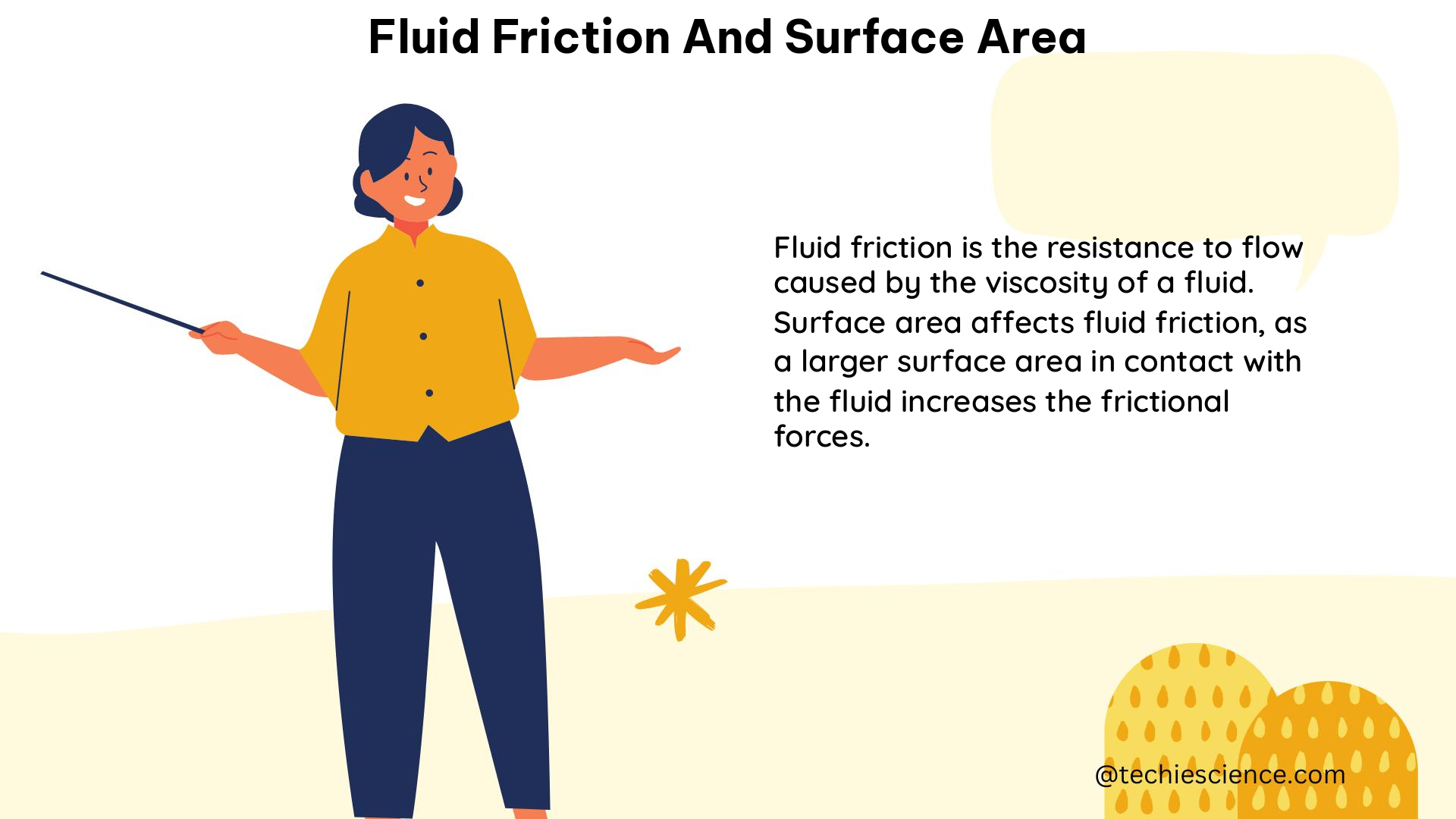Fluid friction and surface area are closely interrelated concepts in physics, with the surface area of an object immersed in a fluid directly affecting the amount of friction it experiences. Understanding the relationship between these two factors is crucial for various applications, from aerodynamic design to fluid dynamics analysis.
Understanding Fluid Friction
Fluid friction, also known as viscous drag, is the force that opposes the relative motion between a fluid and a solid surface. This force arises due to the viscosity of the fluid and the no-slip condition at the fluid-solid interface, where the fluid molecules in contact with the surface have zero velocity relative to the surface.
The magnitude of fluid friction depends on several factors, including:
- Fluid Viscosity: The higher the viscosity of the fluid, the greater the fluid friction experienced by the object.
- Fluid Velocity: The faster the fluid is moving relative to the object, the greater the fluid friction.
- Surface Roughness: Rougher surfaces tend to experience higher fluid friction due to increased turbulence and boundary layer separation.
- Object Shape: The shape of the object can significantly impact the fluid friction, with streamlined shapes generally experiencing lower fluid friction.
Quantifying Fluid Friction: The Reynolds Number

One of the most important parameters used to quantify fluid friction is the Reynolds number (Re or NR), a dimensionless quantity that compares the relative importance of inertial and viscous forces in a fluid flow. The Reynolds number is defined as:
NR = ρ0 v L / η
Where:
– ρ0 is the fluid density (kg/m³)
– v is the fluid velocity (m/s)
– L is a characteristic length of the object perpendicular to the fluid flow (m)
– η is the dynamic viscosity of the fluid (Pa·s or N·s/m²)
The Reynolds number can be used to predict the flow regime and the dominant forces in a fluid flow:
- Low Reynolds Number (NR < 1): Viscous forces dominate, and the flow is typically laminar and smooth.
- High Reynolds Number (NR > 1): Inertial forces dominate, and the flow is often turbulent and chaotic.
Understanding the Reynolds number is crucial for analyzing fluid friction, as it helps determine the appropriate equations and models to use for a given situation.
Fluid Friction and Surface Area
The surface area of an object immersed in a fluid plays a significant role in determining the fluid friction experienced by the object. The relationship between surface area and fluid friction can be expressed through the drag force equation:
Fdrag = 1/2 CD ρ0 A v²
Where:
– Fdrag is the drag force (N)
– CD is the drag coefficient (dimensionless)
– ρ0 is the fluid density (kg/m³)
– A is the cross-sectional area of the object perpendicular to the fluid flow (m²)
– v is the fluid velocity (m/s)
As the surface area (represented by the cross-sectional area A) increases, the drag force experienced by the object also increases, assuming all other factors remain constant. This is because a larger surface area provides a larger target for the fluid to act upon, resulting in a greater force being exerted on the object.
It’s important to note that the drag coefficient CD is also influenced by the object’s shape and surface roughness, as these factors can affect the flow patterns and boundary layer behavior around the object.
Examples and Applications
Example 1: Fluid Friction on a Sphere
Consider a smooth, spherical object with a diameter of 10 cm (0.1 m) moving through water at a velocity of 2 m/s. The density of water is 1000 kg/m³, and the dynamic viscosity of water is 0.001 Pa·s.
-
Calculate the Reynolds number:
NR = ρ0 v L / η
NR = (1000 kg/m³) × (2 m/s) × (0.1 m) / (0.001 Pa·s)
NR = 20,000
This high Reynolds number indicates that the flow is dominated by inertial forces, and the fluid friction is primarily determined by the velocity and size of the object. -
Calculate the drag force:
Fdrag = 1/2 CD ρ0 A v²
Assuming a drag coefficient of 0.47 for a smooth sphere at this Reynolds number, the drag force can be calculated as:
Fdrag = 1/2 × 0.47 × (1000 kg/m³) × (π × (0.1 m)²/4) × (2 m/s)²
Fdrag = 2.35 N
The drag force experienced by the spherical object is 2.35 N.
Example 2: Fluid Friction on a Cylinder
Consider a cylindrical object with a diameter of 5 cm (0.05 m) and a length of 20 cm (0.2 m) moving through air at a velocity of 10 m/s. The density of air is 1.225 kg/m³, and the dynamic viscosity of air is 0.00001 Pa·s.
-
Calculate the Reynolds number:
NR = ρ0 v L / η
NR = (1.225 kg/m³) × (10 m/s) × (0.05 m) / (0.00001 Pa·s)
NR = 61,250
This high Reynolds number indicates that the flow is dominated by inertial forces, and the fluid friction is primarily determined by the velocity and size of the object. -
Calculate the drag force:
Fdrag = 1/2 CD ρ0 A v²
Assuming a drag coefficient of 1.2 for a smooth cylinder at this Reynolds number, the drag force can be calculated as:
Fdrag = 1/2 × 1.2 × (1.225 kg/m³) × (π × 0.05 m × 0.2 m) × (10 m/s)²
Fdrag = 14.7 N
The drag force experienced by the cylindrical object is 14.7 N.
These examples demonstrate how the Reynolds number and the drag force equation can be used to quantify the fluid friction experienced by objects with different shapes and sizes moving through fluids.
Factors Affecting Fluid Friction and Surface Area
In addition to the factors mentioned earlier, there are several other parameters that can influence the relationship between fluid friction and surface area:
- Fluid Compressibility: For high-speed flows, the compressibility of the fluid can become significant, affecting the fluid friction and the drag force.
- Boundary Layer Behavior: The development and behavior of the boundary layer around the object can significantly impact the fluid friction, especially at high Reynolds numbers.
- Surface Roughness and Texture: Rougher surfaces or textured surfaces can alter the boundary layer behavior and the flow patterns, leading to changes in fluid friction.
- Object Orientation: The orientation of the object relative to the fluid flow can affect the effective surface area and the drag coefficient, impacting the fluid friction.
- Fluid Turbulence: Turbulent fluid flow can introduce additional complexities in the fluid friction analysis, requiring more advanced modeling techniques.
Understanding these factors and their influence on fluid friction and surface area is crucial for designing efficient systems, optimizing fluid flow, and predicting the performance of various engineering applications.
Conclusion
Fluid friction and surface area are closely related concepts in physics, with the surface area of an object immersed in a fluid directly affecting the amount of fluid friction it experiences. By understanding the principles of fluid friction, the Reynolds number, and the drag force equation, you can effectively analyze and quantify the fluid friction experienced by objects of different shapes and sizes moving through various fluids.
This comprehensive guide has provided you with the necessary tools and knowledge to delve deeper into the intricacies of fluid friction and surface area, equipping you with the skills to tackle complex problems and design efficient systems in various fields, from aerodynamics to fluid dynamics.
References
- Fluid Friction – Law, Examples, Types, Factors Affecting and Solved Problems. (n.d.). Vedantu. https://www.vedantu.com/physics/fluid-friction
- Fluid Friction and Surface Area. (n.d.). The Physics Classroom. https://www.physicsclassroom.com/class/fluids/Lesson-4/Fluid-Friction-and-Surface-Area
- Reynolds Number. (n.d.). Encyclopædia Britannica. https://www.britannica.com/science/Reynolds-number
- Fluid Mechanics. (n.d.). Khan Academy. https://www.khanacademy.org/science/physics/fluids
- Fluid Dynamics. (n.d.). MIT OpenCourseWare. https://ocw.mit.edu/courses/aeronautics-and-astronautics/16-01-unified-engineering-i-ii-iii-iv-fall-2005-spring-2006/fluid-dynamics/

I am Deepak Kumar Jani, Pursuing PhD in Mechanical- Renewable energy. I have five years of teaching and two-year research experience. My subject area of interest are thermal engineering, automobile engineering, Mechanical measurement, Engineering Drawing, Fluid mechanics etc. I have filed a patent on “Hybridization of green energy for power production”. I have published 17 research papers and two books.
I am glad to be part of Lambdageeks and would like to present some of my expertise in a simplistic way with the readers.
Apart from academics and research, I like wandering in nature, capturing nature and creating awareness about nature among people.
Also refer my You-tube Channel regarding “Invitation from Nature”